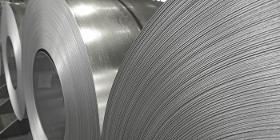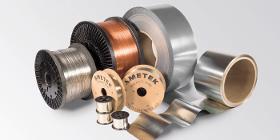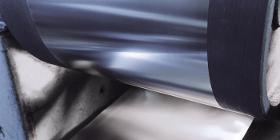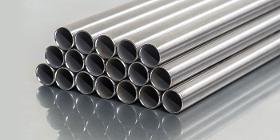- europages
- >
- COMPANIES - SUPPLIERS - SERVICE PROVIDERS
- >
- low-carbon
Results for
Low-carbon - Import export

AMETEK SPECIALTY METAL PRODUCTS
United States
Our High Purity Iron is generally used as a header material for Hermetic Package applications. The material is characterized by the extremely low carbon content (below 100ppm). Additional applications are as a catalyst for synthetic diamond production.
Request for a quote
AMETEK SPECIALTY METAL PRODUCTS
United States
HPM® C 276 is a Nickel-Molybdenum-Chromium-Tungsten alloy with a high level of corrosion resistance. A low carbon content enables the alloy to resist intergranular corrosion at weld joints. These attributes make it an important alloy for the most severe chemical processing applications. such as use in metal diaphragms for aerospace sensors and burst discs. The alloy is readily formed from the annealed temper.All standard welding methods except oxy-acetylene can be used for joining. Available Sizes: HPM® C 276 is available from Hamilton Precision Metals as strip product in thicknesses From 0.0005” to 0.050” (0.0127 mm to 1.27 mm) and widths up to 12.0” (304.8 mm). The material conforms to ASTM B575 and UNS N10276.
Request for a quote
AMETEK SPECIALTY METAL PRODUCTS
United States
HPM 233® Nickel is a commercially pure wrought Nickel with low carbon. The material has excellent corrosion resistance with high thermal and electrical conductivities. A high thermal coefficient of electrical resistance makes it suitable for temperature sensors, and electronic components. The alloy can be formed by all conventional cold-forming methods and can be joined by welding, brazing and soldering. The corrosion resistance is generally very good in most mediums, although it is subject to intergranular embrittlement by sulfur compounds above 315°C. Available Sizes: HPM 233® Nickel is available from Hamilton Precision Metals as strip product in thicknesses from 0.0005” to 0.020” (0.0127 mm to 0.508 mm) in widths up to 12.0” (304.8 mm). It is available as foil as thin as 0.000100” (0.00254 mm) in 4.0” (101.6 mm) maximum width. The material conforms to ASTM B162, ASTM F3, and UNS N02233.
Request for a quote
AMETEK SPECIALTY METAL PRODUCTS
United States
HPM® 201 Nickel is a commercially pure wrought Nickel. With low carbon, the material has excellent corrosion resistance with high thermal and electrical conductivities. Making it perfect for use in flexible metal foil heaters. The alloy can be formed by all conventional cold-forming methods and can be joined by welding, brazing and soldering. The corrosion resistance is generally very good in most mediums, although it is subject to intergranular embrittlement by sulfur compounds above 315°C. Available Sizes: HPM® 201 Nickel is available from Hamilton Precision Metals as strip product in thicknesses from 0.0005” to 0.020” (0.0127 mm to 0.508 mm) in widths up to 12.0” (304.8 mm). It is available as foil as thin as 0.000100” (0.00254 mm) to 4.0” (101.6 mm) maximum width. The material conforms to ASTM B162, and UNS N02201.
Request for a quote
AMETEK SPECIALTY METAL PRODUCTS
United States
SS 304L is an austenitic Chromium-Nickel stainless steel offering the optimum combination of corrosion resistance, strength, and ductility. These attributes make it a favorite for many mechanical switch components, and use in surgical instruments. Low carbon content reduces susceptibility to carbide precipitation during welding. The alloy is readily formed in the annealed temper.SS 304L may be joined by all commonly used brazing and welding methods including oxyacetylene. The corrosive resistance to acids is generally very good with the exception of halogen acids. Available Sizes: SS 304L is available from Hamilton Precision Metals as strip product in thicknesses from 0.0005” to 0.050” (0.0127 mm to 1.27 mm) in widths up to 12.0” (304.8 mm). It is also available in foil as thin as 0.000200” (0.00508 mm) in widths of 4.0” (101.6 mm) maximum. The material conforms to ASTM A240, ASTM A666, FED QQ-S-766, MIL-S-4043, UNS S30403.
Request for a quoteDo you sell or make similar products?
Sign up to europages and have your products listed

AMETEK SPECIALTY METAL PRODUCTS
United States
Stainless steel powder 434L is a low-carbon ferritic steel powder, in mildly corrosive environments or atmospheric exposures, have corrosion resistance approaching that of some nickel stainless steels. These alloys are oxidation resistant at elevated temperatures. Type 434 stainless steel alloys are ductile and do not work-harden readily. The toughness, defined as resistance to crack propagation or notch strength, of ferritic steels is relatively low, and the ductile-to-brittle transition temperature is at or above room temperature. The corrosion and oxidation resistances of the ferritic steels are directly related to their chromium content. The 17% Cr 434 steel alloys have good corrosion resistance to atmospheric conditions. These alloys are used in a variety of applications where corrosion resistance is more important than strength.
Request for a quote
AMETEK SPECIALTY METAL PRODUCTS
United States
Stainless steel powder 430L is a Low-carbon ferritic stainless steels, in mildly corrosive environments or atmospheric exposures, have corrosion resistance approaching that of some nickel stainless steels. These alloys are oxidation resistant at elevated temperatures. Type 430 alloys are ductile and do not work-harden readily. The toughness—defined as resistance to crack propagation or notch strength—of ferritic steels is relatively low, and the ductile-to-brittle transition temperature is at or above room temperature. The corrosion and oxidation resistances of the ferritic steels are directly related to their chromium content. The 17% Cr 430 steel alloys have good corrosion resistance to atmospheric conditions. 430 stainless steel alloys are used in a variety of applications where corrosion resistance is more important than strength. These alloys are resistant to attack in a wide variety of corrosion media.
Request for a quote
AMETEK SPECIALTY METAL PRODUCTS
United States
SS 316L is an austenitic Chromium-Nickel stainless steel with superior corrosion resistance. The low carbon content reduces susceptibility to carbide precipitation during welding. This permits usage in severe corrosive environments such as isolator diaphragms, and metal diaphragms, for both aerospace sensors and burst discs. The alloy can be formed from the annealed temper by stamping and deep drawing. Joining is accomplished by brazing and welding. The Molybdenum is the alloy composition provides excellent strength up through 800° F in applications. Available Sizes: SS 316L is available from Hamilton Precision Metals as strip product from 0.0005” to 0.050” (0.0127 mm to 1.27 mm) in widths up to 12.0” (304.8 mm). It is also available in foil as thin as 0.000200” (0.00508 mm) in widths of 4.0” (101.6 mm) maximum. The material conforms to AMS 5507, ASTM A240, FED QQS766 and UNS S31603.
Request for a quote
AMETEK SPECIALTY METAL PRODUCTS
United States
SS 302 is an austenitic Chromium-Nickel stainless steel offering the optimum combination of corrosion resistance, strength and ductility. These attributes make it a favorite for many mechanical switch components, as well as surgical instruments. The alloy is readily formed in the annealed temper. SS 302 may be joined by all commonly used brazing and welding methods including oxyacetylene. Caution should be used to avoid cooling slowly through the range of 900° to 1600°F where carbide network could form and reduce corrosion resistance. This characteristic is diminished due to the typically low carbon composition of Hamilton’s SS 302. The corrosive resistance to acids is generally very good with the exception of halogen acids.
Request for a quote
AMETEK SPECIALTY METAL PRODUCTS
United States
Grade 316 is the standard molybdenum-bearing grade, second in overall volume production to 304 amongst the austenitic stainless steels. The molybdenum gives 316 better overall corrosion resistant properties than Grade 304, particularly higher resistance to pitting and crevice corrosion in chloride environments. Grade 316L, the low carbon version of 316 and has very high immunity from sensitization (grain boundary carbide precipitation). It is extensively used in the oil and gas and chemical industries for its cost effective corrosion resistance and ease of fabrication. There is commonly no appreciable price difference between 316 and 316L stainless steel. The austenitic structure also gives these grades excellent toughness, even down to cryogenic temperatures. Compared to chromium-nickel austenitic stainless steels, 316L stainless steel offers higher creep, stress to rupture and tensile strength at elevated temperatures. Please note that we have a minimum order value of £10,000.
Request for a quote
AMETEK SPECIALTY METAL PRODUCTS
United States
Alloy 276 is a nickel-molybdenum-chromium superalloy with an addition of tungsten designed to have excellent corrosion resistance in a wide range of severe environments. The high chromium, molybdenum and tungsten contents make the alloy especially resistant to pitting and crevice corrosion in reducing environments while chromium conveys resistance to oxidizing media. The low carbon content minimizes carbide precipitation during welding to maintain corrosion resistance in as-welded structures. This nickel alloy is resistant to the formation of grain boundary precipitates in the weld heat-affected zone, thus making it suitable for most chemical process application in an as welded condition. Alloy 276 is widely used in the most severe environments such as mixed acid chemical processing, pollution control, pulp and paper production, industrial and municipal waste treatment, and recovery of sour oil and gas. Please note that we have a minimum order value of £10,000.
Request for a quote
AMETEK SPECIALTY METAL PRODUCTS
United States
UNS NO8904, commonly known as 904L, is a low carbon high alloy austenitic stainless steel which is widely used in applications where the corrosion properties of AISI 316L and AISI 317L are not adequate. The addition of copper to this grade gives it corrosion resistant properties superior to the conventional chrome nickel stainless steels, in particular to sulphuric, phosphoric and acetic acids. However, there is limited use with hydrochloric acids. It also has a high resistance to pitting in chloride solutions, a high resistance to both crevice and stress corrosion cracking. Alloy 904L performs better than other austenitic stainless steels due to the higher alloying of nickel and molybdenum. The grade is non-magnetic in all conditions and has excellent formability and weldability. The austenitic structure also gives this grade excellent toughness, even down to cryogenic temperatures. Please note that we have a minimum order value of £10,000.
Request for a quote
AMETEK SPECIALTY METAL PRODUCTS
United States
316LN (UNS S31653) is a low-carbon, nitrogen-enhanced version of Type 316 molybdenum-bearing austenitic stainless steel. The Type 316 alloys are more resistant to general corrosion and pitting/crevice corrosion than the conventional chromium-nickel austenitic stainless steels such as Type 304. They also offer higher creep, stress-rupture and tensile strength at elevated temperature. The nitrogen in Type 316LN adds additional resistance to sensitization in some circumstances. The nitrogen content of Type 316LN stainless steel also provides some solid solution hardening, raising its minimum specified yield strength compared to Type 316L stainless steel. Like Types 316 and 316L, the Type 316LN alloy also offers good resistance to general corrosion and pitting/crevice corrosion. Please note that we have a minimum order value of £10,000.
Request for a quote
AMETEK SPECIALTY METAL PRODUCTS
United States
Grade 316 is the standard molybdenum-bearing grade, second inoverall volume production to 304 amongst the austenitic stainless steels. The molybdenum gives 316 better overall corrosion resistant properties than Grade 304, particularly higher resistance to pitting and crevice corrosion in chloride environments. Grade 316L, the low carbon version of 316 and has very high immunity from sensitization (grain boundary carbide precipitation). It is extensivly used in the oil and gas and chemical industries for its cost effective corrosion resistance and ease of fabrication. There is commonly no appreciable price difference between 316 and 316L stainless steel. The austenitic structure also gives these grades excellent toughness, even down to cryogenic temperatures. Compared to chromium-nickel austenitic stainless steels, 316L stainless steel offers higher creep, stress to rupture and tensile strength at elevated temperatures. Please note that we have a minimum order value of £10,000.
Request for a quoteResults for
Low-carbon - Import exportNumber of results
15 ProductsCountries
Company type